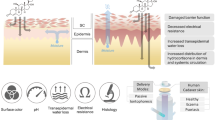Abstract
Purpose. To investigate pharmacokinetic differences between the non-halogenated double ester prednicarbate (PC) and the fluorinated monoester betamethasone 17-valerate (BM17V) their metabolism in human keratinocytes and fibroblasts as well as their permeation and biotransformation in reconstructed epidermis and excised human skin was compared. Special attention was given to the 17-monoesters because of their high receptor affinity and antiproliferative effects.
Methods. Glucocorticoid penetration was determined using Franz diffusion cells, quantifying metabolite concentrations by HPLC. Chemical stability and reactivity of the monoesters was determined by molecular modeling analysis.
Results. PC accumulated in the stratum corneum. A considerable amount of penetrating PC was hydrolyzed by viable keratinocytes to prednisolone 17-ethylcarbonate (P17EC). P17EC permeated the skin very rapidly when compared to BM17V. Overall P17EC concentrations in viable tissue were low. Inside of the acceptor fluid, but not within the tissue, P17EC was converted to the more stable prednisolone 21-ethylcarbonate (P21EC).
Conclusions. The inactivation of highly potent, but also cell toxic, 17-monoesters to almost inactive 21-congeners seen with isolated cell monolayers appears less important in the skin. In vitro determination of the dermal 17-monoesters concentrations may allow the prediction of the atrophogenic risk in man. BM17V levels exceeding P17EC concentrations about 6-fold may contribute to its lower tolerance when compared to PC.
Similar content being viewed by others
REFERENCES
M. Schäfer-Korting, H. C. Korting, M. J. Kerscher, and S. Lenhard. Prednicarbate activity and benefit/risk ratio in relation to other topical glucocorticoids. Clin. Pharmacol. Ther. 54:448-456 (1993).
N. Bodor. The application of soft drug approaches to the design of safer corticosteroids. In E. Christophers, E. Schöpf, A. M. Kligman, and R. B. Stoughton (eds.), Topical Corticosteroid Therapy—A Novel Approach to Safer Drugs, Raven Press, New York, 1988, pp. 13-25.
A. Gysler, K. Lange, H. C. Korting, and M. Schäfer-Korting. Prednicarbate biotransformation in human foreskin keratinocytes and fibroblasts. Pharm. Res. 14:793-97 (1997).
K. Lange, A. Gysler, B. Kleuser, M. Bader, H. C. Korting, and M. Schäfer-Korting. Prednicarbate versus conventional topical glucocorticoids: pharmacodynamic characterization in-vitro. Pharm Res. 14:7744-1749 (1997).
S. W. Collier, N. M. Sheikh, A. Sakr, J. L. Lichtin, R. F. Stewart, and R. L. Bronaugh. Maintenance of skin viability during in vitro percutaneous absorption/metabolism studies. Toxicol. Appl. Pharmacol. 99:522-533 (1989).
O. H. Lowry, N. J. Rosenbrough, A. Lewis Farr, and R. J. Randall. Protein measurement with the Folin phenol reagent. J. Biol. Chem. 193:265-275 (1951).
P. K. Smith, R. I. Krohn, G. T. Hermanson, F. H. Gartner, M. D. Provenzano, E. K. Fujimoto, N. M. Goeke, B. J. Olson, and D. C. Klenk. Measurement of protein using bicinchonic acid. Anal. Biochem. 150:76-85 (1985).
H.-D. Höltje and G. Folkers. Molecular Modelling-Basic Principles and Applications, VCH Publisher, New York, 1996.
M. J. S. Dewar, E. G. Zoebisch, E. F. Healy, and J. J. P. Stewart. AM1: A new general purpose quantum mechanical molecular model. J. Am. Chem. Soc. 107:3902-3909 (1985).
C. J. Cramer and D. G. Truhlar. General parameterized SCF model for free energies of solvation in aqueous solution. J. Am. Chem. Soc. 113:8305-8311 (1991).
W. S. Watson and A. Y. Finlay. The effect of the vehicle formulation on the stratum corneum penetration characteristics of clobetasol propionate in vivo. Br. J. Dermatol. 118:523-527 (1988).
H. C. Korting, D. Vieluf, and M. Kerscher. 0.25% Prednicarbate cream and the corresponding vehicle induce less skin atrophy than 0.1% betamethasone 17-valerate cream and 0.05% clobetasol 17-propionate cream. Eur. J. Clin. Pharmacol. 42:159-161 (1992).
A. M. Kligman. Skin permeability: Dermatologic aspects of transdermal drug delivery. Am. Heart J. 108:200-206 (1984).
A. Rougier, D. Dupuis, C. Lotte, R. Roguet, and H. Schaefer. In vivo correlation between stratum corneum reservoir function and percutaneous absorption. J. Invest. Dermatol. 81:275-278 (1983).
U. Täuber and K. L. Rost. Esterase activity of the skin including species variations. In B. Shroot and H. Schaefer (eds.), Pharmacology and the Skin, Karger, Basel, 1987, pp. 170-183.
M. Pörtner, H. Möllmann, and P. Rohdewald. Glucocorticoid receptors in human synovial tissue and relative receptor affinities of glucocorticoid-21-esters. Pharm. Res. 10:623-627 (1988).
G. Würthwein, S. Rehder, and P. Rohdewald. Lipophilicity and receptor affinity of glucocorticoids. Pharm. Ztg. Wiss. 4:161-167 (1992).
J. Levy, J. Gassmüller, G. Schröder, H. Audring, and N. Sönnichsen. Comparison of the effects of calcipotriol, prednicarbate and clobetasol 17-propionate on normal skin assessed by ultrasound measurement of skin thickness. Skin Pharmacol. 7:231-236 (1994).
M. Liebsch, B. Döring, T. A. Donelly, P. Logemann, L. A. Rheins, and H. Spielmann. Application of the human dermal model Skin2 ZK 1350 to phototoxicity and skin corrosivity testing. Toxicol. in Vitro 9:557-562 (1995).
G. E. Pièrard, V. Goffin, T. Herrmanns-Le, J. Arrese, and C. Pièrard-Franchimont. Surfactant-induced dermatitis: Comparison of corneosurfametry with predictive testing on human and reconstructed skin. J. Am. Acad. Dermatol. 33:462-469 (1995).
A. Gysler, U. Bacher, and M. Schäfer-Korting. Penetration und Metabolisierung von Glucocorticoiden bei Hautäquivalenten und exzidierter Humanhaut. In H. Schöffl, H. Spielmann, and H. A. Tritthart (eds.), Do it in Vitro, Springer Verlag, Wien, New York, in press.
Author information
Authors and Affiliations
Corresponding author
Rights and permissions
About this article
Cite this article
Gysler, A., Kleuser, B., Sippl, W. et al. Skin Penetration and Metabolism of Topical Glucocorticoids in Reconstructed Epidermis and in Excised Human Skin. Pharm Res 16, 1386–1391 (1999). https://doi.org/10.1023/A:1018946924585
Issue Date:
DOI: https://doi.org/10.1023/A:1018946924585




